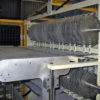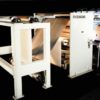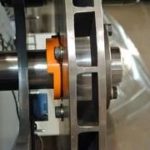C.A. Hubbard, a division of the Kapaco Group, Inc., is a contract sheeter and paper wholesaler that deals nationwide. Located in Kalamazoo, Mich., the company successfully converts a variety of materials. However, it found itself in the position of being unable to effectively compete with other custom converters in solid bleached sulfate (SBS) board market.
President Richard Jones explains that Hubbard has been converting SBS board using and older sheeter and guillotine trimmer. The two pieces of equipment, Jones realized, were not able to provide the same cost-efficient operations for SBS as they do for Hubbard’s lightweight products.
In order to match delivery times and prices of competitors in the SBS market, the 60-yr-old company would have to find a sheeter with higher speed capabilities.
Jones led an extensive, 15-mo study of eight sheeters, consulting with other board converters on overall performance. After investigating all alternatives, he settled on 57-in. MSH precision sheeter from Maxson Automatic Machinery Co.
Since installing the sheeter in early 1986, productivity has doubled, waste level has dropped from six to three percent and costs have come down.

Sheeting speeds double
Jones points out that higher operating speeds are key to achieving the quick turnaround time dictated by customers. “Operators were running the older sheeters at 500 feet per minute, then trimming all four sides,” notes Jones. “Now, they’re operating the MSH sheeter at 1,000 feet per minute-nearly double the speed-and are getting orders filled and ready for shipment within 72 hours, or much sooner.”
Currently, the sheeter is used 80 percent for the conversion of SBS board (in basis weights of 8, 10 and 12 pt) and twenty percent of the time for uncoated offset and coated enamel paper sheeting.
Pile looks good
To meet customer requirements for even piles, Hubbard depends on the provide close tolerances in a variety of widths and cutoff lengths. The converted board stacks more evenly than any other paper product in the plant, he says.
“Quality of the cut seems to be about the same for most sheeters. But the quality of the pile is what makes Maxson stand out,” reports Jones, who purchased Maxson’s Series 600 stacker. “It provides an even sided, well-jogged pile that has helped make us successful in the marketplace.”
Feature all contribute
“The ability to adjust the sheeting equipment from material to material in a short amount of time is also critical to making order deadlines,” Jones says. “Our operator have remarked on the relatively short period it takes to make sheeting length adjustments on the MSH sheeter. It is customized to sheet a 21- to 76-inch cutoff and is equipped with two shaftless self-loading back stands, so two rolls of material can be simultaneously sheeted instead of one.”
In addition, a Maxson-patented Airfoil Overlap system provides faster sheet feeding from the cutting section to the stacker and has reduced downtime by preventing jam-ups at the point of overlap, about 2 or 3 ft beyond the knife.
According to Jones, several other features on the Maxson equipment help improve the machine’s efficiency and overall production levels. A Pen-Man Dust Collector located at the delivery tape section of the sheeter is an important component in keeping it clean. Dust particles generated by cutting and slitting can later affect print quality by contaminating the blankets on an offset press. With the Pen-Man Collector, dust is suctioned off the sheet through flexible hosing and collected in a box with four individual filters.
An extending grid system allows the operator to continually sheet stock while offloading the stacker, saving valuable production time.
Handling with care
Products are handled with quality throughout the entire converting and shipping process at Hubbard. Jones explains that all converted board and paper is wrapped in plastic film to maintain a constant moisture level. “We’re probably the only independent converter that operates under a humidity-and temperature-controlled environment,” he concedes. Hubbard’s plant is air-conditioned to prevent curling and buckling.
Before it is shipped, each order is checked for flaws to ensure the end size meets customer requirements.
Based on customer comments, and, of course, on results, Jones believes that purchasing the Maxson precision sheeter was the best move Hubbard could have made to improve its position in the SBS board market.
Reprinted from Converting, September 1987






